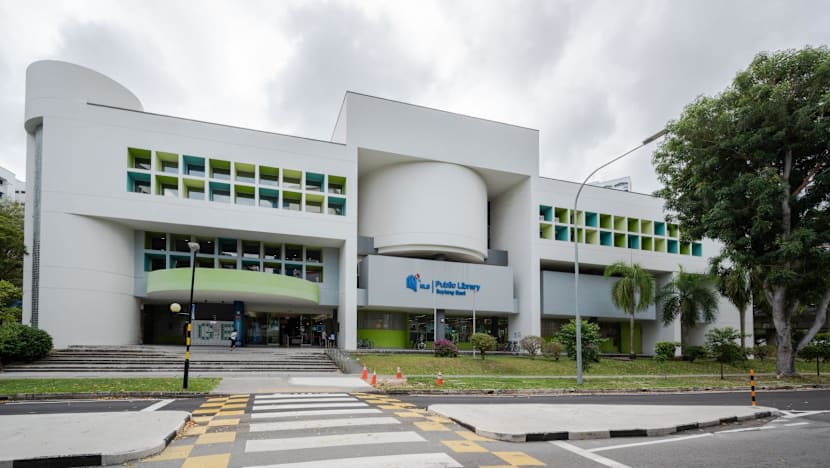Drop in visitorship, high revamp cost among reasons to relocate Geylang East Public Library
Ms Tin Pei Ling had earlier appealed to the National Library Board to reconsider its decision to relocate the library.

Geylang East Public Library opened in 1988 and was refurbished in 2012. The library is slated to be relocated to Tanjong Katong Complex in 2030. (Photo: NLB)

This audio is generated by an AI tool.
SINGAPORE: The decline in visitors and the high costs of renovation were considered in the decision to relocate Geylang East Public Library to Tanjong Katong Complex in 2030, Minister of State for Digital Development and Information Rahayu Mahzam said in parliament on Tuesday (Sep 23).
From 2015 to 2024, Geylang East library saw about a 31 per cent decrease in visitors, from 670,000 to less than 470,000, she said.
While the National Library Board (NLB) had considered revamping the library at its current site at 50 Geylang East Ave 1, the cost of doing so would be more than twice the cost per square metre compared to relocating it to Tanjong Katong Complex.
The budgetary difference translates to S$22 million (US$16.3 million), Ms Rahayu said.
Ms Rahayu was responding to MP Tin Pei Ling's adjournment motion, in which she raised questions about visitorship trends at Geylang East library and the costs of maintaining it as a standalone library.
Ms Tin (PAP-Marine Parade-Braddell Heights) said residents had expressed concerns over the decision to relocate Geylang East Public Library.
“To them, the building is more than a physical icon in MacPherson, but a huge part of their memories – our collective memories. To learn of the relocation, we all feel a deep sense of loss,” she said.
In a Facebook post in July, Ms Tin wrote that she had appealed to NLB to reconsider its decision to relocate Geylang East library.
Several residents also launched a petition to oppose the library's relocation. As of Sep 23, the petition has attracted 1,647 signatures.
STANDALONE SITES TO MALLS
In July, CNA reported that more libraries at standalone sites, including Geylang East library, are being relocated to shopping malls or integrated complexes.
Besides the Geylang East Public Library, there are plans to relocate the Ang Mo Kio library, Toa Payoh library and Jurong Regional Library to either malls or integrated complexes in the coming years.
Ms Rahayu said that NLB's strategy to relocate standalone libraries to places with “easy access”, such as malls and integrated hubs, is part of its 15-year Libraries of the Future Masterplan.
“The decision to relocate any library is not taken lightly,” she said.
Before deciding whether to relocate a library or to revamp it in situ, NLB considers various factors. They include land use plans, the number of residents it can best serve, the library's age and the number of years since the last major renovation, she said.
The relocation of Geylang East library reflects NLB’s approach, she said.
“We hope the relocation will help to improve the visitorship for the library, just as it did for the libraries at Harbourfront and Tampines,” she said.
Over three years, the public libraries at Harbourfront and Tampines saw a 58 per cent and 71 per cent increase in visitorship respectively, she added.
In a written reply on Wednesday, Minister for Digital Development and Information Josephine Teo noted that the NLB's experience shows relocating libraries has generally resulted in higher visitor numbers.
Mrs Teo was replying to Workers’ Party MP Kenneth Tiong’s questions on the civic and heritage value of public libraries against the economic value of the land, and how this value is calculated and factored into the relocation of the Ang Mo Kio and Geylang East public libraries.
She said that mall libraries receive about "30 per cent more visitors per month" on average than standalone libraries over three years.
Mrs Teo added that the average monthly visitorship of a mall library is about 60,000, while the monthly average visitorship to Ang Mo Kio Library and Geylang East Library is only about 50 to 60 per cent of that.
By relocating Ang Mo Kio Library and Geylang East Library to nearby malls, it will enable NLB to serve more residents, she said.
On Tuesday, Ms Tin also raised questions on what the NLB will do to ensure that Geylang East residents continue to have easy access to library space.
In response, Ms Rahayu said that the NLB has engaged residents to better understand their needs.
She added that the NLB is working to identify a suitable space to provide “some form of library presence”, such as a reading corner or a pop-up library.
“We will also work with relevant grassroots organisations to help residents access NLB’s digital resources for delivery services, ensuring continued reading and learning opportunities,” she said.
In response to Ms Tin’s question about overall readership trends, Ms Rahayu said that numbers have remained strong.
In 2024, there were 20.8 million visitors to NLB’s network of libraries, the National Library and the National Archives.
Library patrons also checked out 24 million physical items and 14.8 million digital items that year, she added.
In today’s digital age, libraries play an “even more critical role” as community institutions that can foster a sense of rootedness in community amongst patrons, she said.
“We will continue to develop our libraries and strengthen its mandate as a key community node to foster learning and reading in this digital age.”
















